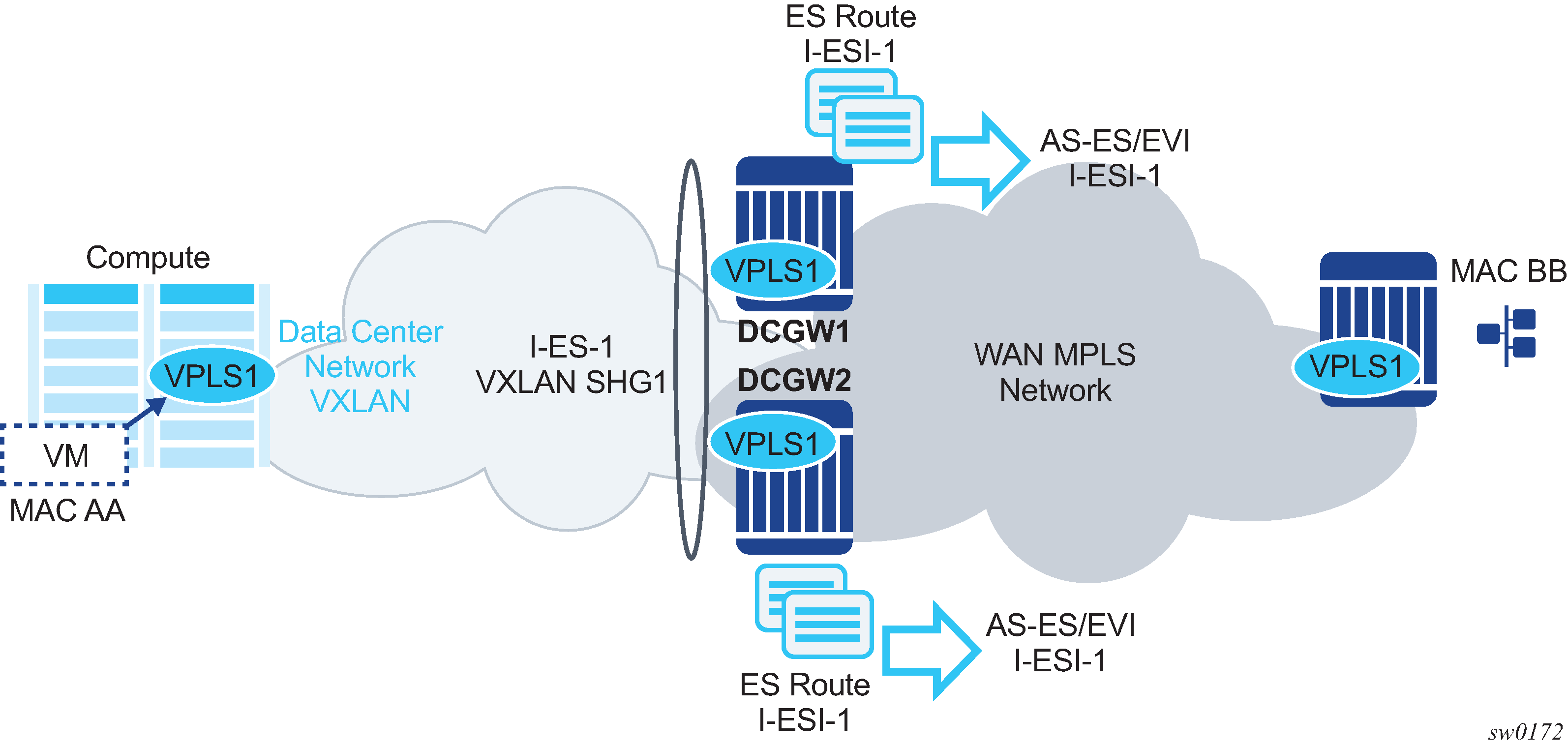SR OS supports Interconnect ESs (I-ES) for VXLAN as per RFC9014. An I-ES is a virtual ES that allows DCGWs with two BGP instances to handle VXLAN access networks as any other type of ES. I-ESs support the RFC 7432 multihoming functions, including single-active and all-active, ESI-based split-horizon filtering, DF election, and aliasing and backup on remote EVPN-MPLS PEs.
In addition to the EVPN multihoming features, the main advantages of the I-ES redundant solution compared to the redundant solution described in Anycast redundant solution for dual BGP-instance services are as follows.
-
The use of I-ES for redundancy in dual BGP-instance services allows local SAPs on the DCGWs.
-
P2MP mLDP can be used to transport BUM traffic between DCs that use I-ES without any risk of packet duplication. As described in Using P2MP mLDP in redundant anycast DCGWs, packet duplication may occur in the anycast DCGW solution when mLDP is used in the WAN.
Where EVPN-MPLS networks are interconnected to EVPN-VXLAN networks, the I-ES concept applies only to the access VXLAN network; the EVPN-MPLS network does not modify its existing behavior.
Figure 1 shows the use of I-ES for Layer 2 EVPN DCI between VXLAN and MPLS networks.

The following example shows how I-ES-1 would be provisioned on DCGW1 and the association between I-ES to a specified VPLS service. A similar configuration would occur on DCGW2 in the I-ES.
New I-ES configuration:
DCGW1#config>service>system>bgp-evpn#
ethernet-segment I-ES-1 virtual create
esi 01:00:00:00:12:12:12:12:12:00
service-carving
mode auto
multi-homing all-active
network-interconnect-vxlan 1
service-id
service-range 1 to 1000
no shutdown
Service configuration:
DCGW1#config>service>vpls(1)#
vxlan instance 1 vni 1 instance 1 create
exit
bgp
route-distinguisher 1:1
bgp 2
route-distinguisher 2:2
bgp-evpn
evi 1
vxlan bgp 1 vxlan-instance 1
no shutdown
exit
mpls bgp 2
auto-bind-tunnel resolution any
no shutdown
...
DCGW1#config>service>vpls(2)#
vxlan instance 1 vni 2 create
exit
bgp
route-distinguisher 3:3
bgp 2
route-distinguisher 4:4
bgp-evpn
evi 2
vxlan bgp 1 vxlan-instance 1
no shutdown
exit
mpls bgp 2
auto-bind-tunnel resolution any
no shutdown
sap 1/1/1:1 create
exit
The above configuration associates I-ES-1 to the VXLAN instance in services VPLS1 and VPLS 2. The I-ES is modeled as a virtual ES, with the following considerations.
-
The commands network-interconnect-vxlan and service-id service-range svc-id [to svc-id] are required within the ES.
-
The network-interconnect-vxlan parameter identifies the VXLAN instance associated with the virtual ES. The value of the parameter must be set to 1. This command is rejected in a non-virtual ES.
-
The service-range parameter associates the specific service range to the ES. The ES must be configured as network-interconnect-vxlan before any service range can be added.
-
The ES parameters port, lag, sdp, vc-id-range, dot1q, and qinq cannot be configured in the ES when a network-interconnect-vxlan instance is configured. The source-bmac-lsb option is blocked, as the I-ES cannot be associated with an I-VPLS or PBB-Epipe service. The remaining ES configuration options are supported.
-
All services with two BGP instances associate the VXLAN destinations and ingress VXLAN instances to the ES.
-
-
Multiple services can be associated with the same ES, with the following considerations.
-
In a DC with two DCGWs (as in Figure 1), only two I-ESs are needed to load-balance, where one half of the dual BGP-instance services would be associated with one I-ES (for example, I-ES-1, in the above configuration) and one half to another I-ES.
-
Up to eight service ranges per VXLAN instance can be configured. Ranges may overlap within the same ES, but not between different ESs.
-
The service range can be configured before the service.
-
-
After the I-ES is configured using network-interconnect-vxlan, the ES operational state depends exclusively on the ES administrative state. Because the I-ES is not associated with a physical port or SDP, when testing the non-revertive service carving manual mode, an ES shutdown and no shutdown event results in the node sending its own administrative preference and DP bit and taking control if the preference and DP bit are higher than the current DF. This is because the peer ES routes are not present at the EVPN application layer when the ES is configured for no shutdown; therefore, the PE sends its own administrative preference and DP values. For I-ESs, the non-revertive mode works only for node failures.
-
A VXLAN instance may be placed in MhStandby under any of the following situations:
-
if the PE is single-active NDF for that I-ES
-
if the VXLAN service is added to the I-ES and either the ES or BGP-EVPN MPLS is shut down in all the services included in the ES
The following example shows the change of the MhStandby flag from false to true when BGP-EVPN MPLS is shut down for all the services in the I-ES.
A:PE-4# show service id 500 vxlan instance 1 oper-flags =============================================================================== VPLS VXLAN oper flags =============================================================================== MhStandby : false =============================================================================== A:PE-4# configure service vpls 500 bgp-evpn vxlan shutdown *A:PE-4# show service id 500 vxlan instance 1 oper-flags =============================================================================== VPLS VXLAN oper flags =============================================================================== MhStandby : true ===============================================================================
-